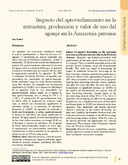Impacto del aprovechamiento en la estructura, producción y valor de uso del aguaje en la Amazonía peruana
Alternative title
Impact of aguaje’s harvesting on the ecosystem structure, production and use value in the Peruvian Amazon
Abstract
Los aguajales son ecosistemas amazónicos donde la especie predominante es Mauritia flexuosa L.f. (aguaje) y constituyen un recurso renovable que ofrece una serie de beneficios económicos, sociales y ambientales. El objetivo del estudio fue determinar el impacto del aprovechamiento tradicional destructivo del aguaje sobre la estructura del bosque, el potencial económico y la producción, así como los efectos sobre la regeneración natural de los aguajales. En 1995 se realizaron inventarios forestales en aguajales que presentaban tres intensidades de aprovechamiento: fuerte, moderado y bajo; los cuales fueron remedidos cinco años después. Se comprobó una disminución significativa (p <0,005) en el número de individuos/ha en aguajales bajo las tres intensidades del aprovechamiento, aunque mayor en el aguajal de bajo aprovechamiento, que se redujo de 194 ± 17 a 128 ± 12 palmeras/ha. El aprovechamiento tiene un efecto sobre la proporción de palmeras según sexo; se detectó una disminución significativa de individuos adultos y, en particular, de individuos femeninos (p <0,005). En aguajales de moderado y fuerte aprovechamiento, se redujo significativamente el número de individuos con mayor producción de racimos. De igual manera, la estructura diamétrica en los tres sitios sufrió variaciones en el rango 30-40 cm, al disminuir el número de individuos. En el aguajal de fuerte aprovechamiento, después de cinco años, la regeneración era prácticamente inexistente. Se comprobó que el valor económico de los aguajales se redujo en casi un 47% del valor inicial. ‘Aguajales’ are Amazon ecosystems with predominance of the palm species Mauritia flexuosa L.f. (aguaje). This is a valuable renewable resource that provides diverse economic, social and environmental benefits. The study was aimed at determining the impact of traditional destructive harvesting on the forest structure, economic potential and production, as well as its effects on the regeneration of aguajales. In 1995 forest inventories were carried out in aguajales showing three harvesting intensities: heavy, moderate and light; five years thereafter, the same places were re-measured. A significant decrease (p <0.005) in the number of individuals/ha was proved with all three harvesting intensities, though higher in the low harvesting intensity (from 194 ± 17 to 128 ± 12 palms/ha). Harvesting has an effect on the proportion of palms by sex; a significant decrease of both adults and female plants (p <0.005) was detected in the three aguajales. Sites moderately and heavily harvested showed a reduction in the number of bunches per palm tree. Similarly, the diameter structure in all sites evaluated underwent variations in the 30-40 cm range with decreasing number of plants. After five years, in the heavily harvested site regeneration was virtually nonexistent. The economic value of aguajales showed a loss of 47% of its initial value.
Keywords
Publisher
CATIE, Turrialba (Costa Rica) CATIE, Turrialba (Costa Rica)



